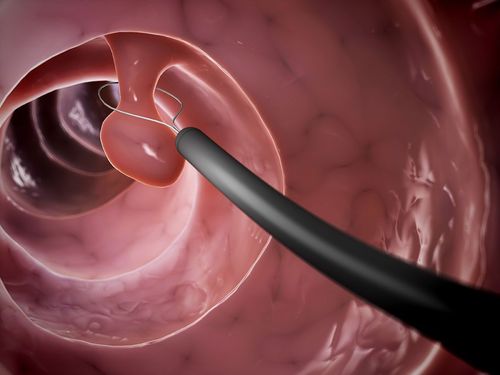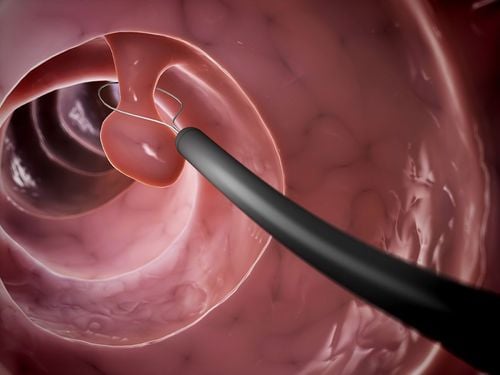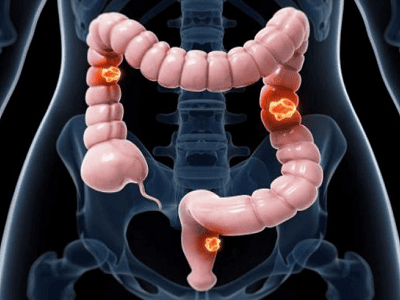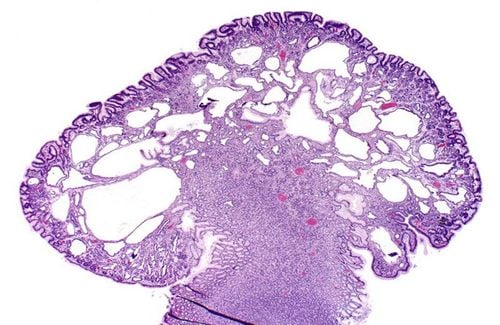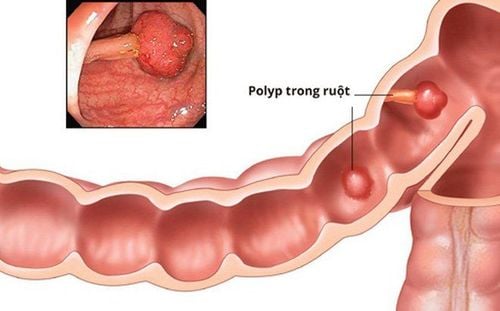This is an automatically translated article.
The article was professionally consulted by MSc Vu Van Quan - Gastroenterologist, Department of General Surgery & Anesthesiology - Vinmec Hai Phong International General HospitalColon polyps are tumor-like lesions that can be pedunculated or sessile. They are formed by the overgrowth of the colonic mucosa. Colon polyps are mostly benign, but there are some cases where polyps turn malignant and have the potential to progress to colon cancer or colorectal cancer.
1. Learn about colon polyps
Polyps can appear in many locations in the digestive tract but are most common in the colon. Both men and women are at risk for colon polyps. Small flesh-like polyps grow from the lining of the intestine and protrude, into the lumen of the intestine. Sometimes they grow on a "stalk" that looks like a mushroom.
However, in some cases polyps can also be flat. Several polyps are scattered in different parts of the colon. The nature of colon polyps is not a tumor but a lesion shaped like a tumor, with or without a peduncle. This lesion is caused by the colonic mucosa and the proliferative submucosa.
Colon polyps can protrude into the colon lumen or be flat. A person can have many colon polyps and their sizes will vary, some as small as a pea, but in some cases much larger colon polyps (such as a ping pong ball). Most colon polyps are benign, but there is still some chance of becoming malignant (cancerous). So, the more colon polyps a person has or has a few polyps but large size, need to be careful, alert, not subjective, because, it is very likely to become colorectal cancer at any time. any.

2. Causes of colon polyps
The cause of colon polyps has not been determined with certainty, but there are many documents and studies that suggest that the cause of colon polyp formation is mainly due to genetic mutations that cause abnormal cell growth. polyps and even cancer. Normally, cell proliferation is controlled by two groups of genes, which are oncogenes and tumor suppressor genes. A mutation in any of these two groups of genes can cause cells to overgrow and form tumors or polyps. In the colon, this proliferation will form tumors and most worryingly some of these tumors (polyps) can become cancerous (in the long run, it takes years).
In addition, the cause may be due to unreasonable diet and living. When the diet is too high in fat, red meat (beef, buffalo, dog...) or eating less vegetables, fruits, fiber, or being lazy, sedentary can be factors that cause polyps. Colon . People who smoke, are obese or have chronic colitis ... can be considered as one of the risk factors for colon polyps. In addition, genetic factors are also mentioned in the cases of blood relatives (grandparents, parents, brothers, sisters) having colon polyps leading to familial polyps.
3. Manifestations of colon polyps

People with colon polyps often have silent developments, especially small polyps, only discovered when incidentally taking a colonoscopy or colonoscopy for another reason. Therefore, most patients with small polyps do not have any unusual symptoms. However, in some patients there are symptoms of bloody stools. This is the most common symptom. You may see fresh blood streaking or spreading on the stool or see blood on the toilet paper when you have a bowel movement or there are cases where the stools are mixed with brown, black or fish-like blood (like the stool of a person with bacillus dysentery). ). Especially when stools are soft or broken and accompanied by blood.
Most patients have mild to moderate bleeding, and severe bleeding that causes severe blood loss is less common. There may be abdominal cramps due to large polyps, stimulating bowel movements and causing pain, these cases are easily confused with dysentery. Some cases of abdominal pain accompanied by nausea, vomiting, bowel obstruction or defecation are easily confused with bowel obstruction or semi-obstruction.
For the diagnosis of colon polyps, a prepared colonoscopy (enema and contrast agent) is required, preferably colonoscopy. Colonoscopy will be the best method to examine the colon because it helps to see the entire lining of the colon and may be accompanied by a biopsy to check for foreign cells (malignant cells). . In addition, magnetic resonance imaging can be performed.
4. Polyps and the ability to turn into cancer
In fact, there are two common types of colon polyps, which are hyperplastic polyps and adenomatous polyps. Hyperplastic polyps are not usually cancerous. Adenomatous polyps are thought to be a precursor to most colon cancers, although adenomas do not always become cancerous. But large polyps are more likely to become cancerous, and some very large polyps (more than 2cm) may have small areas of cancerous growth. Therefore, the patient should not be subjective with this disease.
At Vinmec International General Hospital, the combination of a modern, synchronous flexible bronchoscope system with high resolution - endoscopy with narrow light frequency range - endoscopy with staining and endoscopic procedures Standard endoscopy combined with good anesthesia, therefore, is very effective in endoscopic diagnosis and treatment of colon polypectomy.
Treatment of colon polypectomy through flexible endoscopic tube at Vinmec International General Hospital is performed in accordance with the standard technical process of the Japanese and international endoscopic mucosalectomy technique, ensuring effective treatment and achieve a very high level of safety for patients, preventing the risk of developing colon cancer.
Please dial HOTLINE for more information or register for an appointment HERE. Download MyVinmec app to make appointments faster and to manage your bookings easily.





